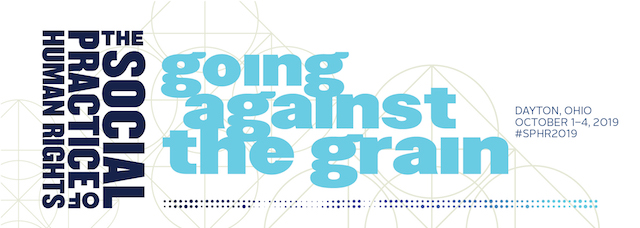Location
Community-Based Global Learning
Start Date
10-2-2019 2:00 PM
End Date
10-2-2019 3:30 PM
Keywords
Art Education, Preservice Education, Visual Culture, Empowerment
Abstract
Our lives are mediated through the visual which informs, in multiple and conflicting ways, our views, our beliefs, attitudes and mores, our choices, and thereby our resulting actions. This barrage of the visual impacts the postmodern student encountered in K-12 education. Students readily gain access to information that was once the sole domain of adults yet the prevailing system of education has not adapted. Visual culture is seldom used as an engagement strategy in school despite its ubiquitous role as hidden curriculum and ever-present place in the world beyond the school.
Social justice education underscores humanizing pedagogy as it examines and challenges power relationships in the classroom (Anderson, 2010), fostering a space for students to gain a clearer understanding of the world in which they live (Garber, 2005) and be active participants in their education (Dewhurst, 2011; Hackman, 2005). It is both goal and process (Bell, 1997) through which youth can explore issues of power and critically examine the role of media and socio-cultural forces in relationship to power (Chung, 2008). As students use semiotic pedagogy to connect to each other, question their world and translate their beliefs into action (Dewhurst, 2011) they are empowered; they become active participants in the creation of the curriculum through their voices, lives, and interests. Youth empowerment is an inclusive, participatory, ongoing, and a critical educational process (Williams-Boyd, 2004) through which those who have been marginalized or disempowered are put back in the driver’s seat.
This presentation will share the findings of a qualitative action research study, grounded in social justice art education, in which pre-service art educators worked collaboratively to integrate visual culture into the curriculum to bring Dayton middle school student’s voices to the forefront. They planned, delivered and assessed art education lessons that fostered meaning making, critical engagement, and development of artistic and activist voice.
Author/Speaker Biographical Statement(s)
Dr. Bradshaw is Associate Professor of Art Education and Area Coordinator for Art Education in the Department of Art & Design at the University of Dayton. She holds both a PhD in Art History and Education and an MFA in Fiber Art from the University of Arizona, Tucson, AZ. Her scholarship focuses on art integration, empathy development through arts, visual journaling, and the training of preservice teachers. Dr. Bradshaw worked as an Arts Integration Specialist within the K-12 system in the Southwestern United States for six years and facilitated Arts Integration trainings across the U.S. for the non-profit Arts Integration Solutions. She continues to offer professional development in art integration methods nationally and internationally. She has presented at regional and national conferences on the visual culture of the Arpillera, the potential of art integration to foster empathy development, and challenging White supremacy in art education. Dr. Bradshaw is also a practicing fiber artist exhibiting her work regionally and nationally.
Included in
Pre-Service Teachers and Middle School Students: A Collaboration for Social Justice Art Education
Community-Based Global Learning
Our lives are mediated through the visual which informs, in multiple and conflicting ways, our views, our beliefs, attitudes and mores, our choices, and thereby our resulting actions. This barrage of the visual impacts the postmodern student encountered in K-12 education. Students readily gain access to information that was once the sole domain of adults yet the prevailing system of education has not adapted. Visual culture is seldom used as an engagement strategy in school despite its ubiquitous role as hidden curriculum and ever-present place in the world beyond the school.
Social justice education underscores humanizing pedagogy as it examines and challenges power relationships in the classroom (Anderson, 2010), fostering a space for students to gain a clearer understanding of the world in which they live (Garber, 2005) and be active participants in their education (Dewhurst, 2011; Hackman, 2005). It is both goal and process (Bell, 1997) through which youth can explore issues of power and critically examine the role of media and socio-cultural forces in relationship to power (Chung, 2008). As students use semiotic pedagogy to connect to each other, question their world and translate their beliefs into action (Dewhurst, 2011) they are empowered; they become active participants in the creation of the curriculum through their voices, lives, and interests. Youth empowerment is an inclusive, participatory, ongoing, and a critical educational process (Williams-Boyd, 2004) through which those who have been marginalized or disempowered are put back in the driver’s seat.
This presentation will share the findings of a qualitative action research study, grounded in social justice art education, in which pre-service art educators worked collaboratively to integrate visual culture into the curriculum to bring Dayton middle school student’s voices to the forefront. They planned, delivered and assessed art education lessons that fostered meaning making, critical engagement, and development of artistic and activist voice.




Comments
References
Anderson,T. (2010). An introduction to art education for social justice. In T. Anderson, D. Gussak, K.K. Hallmark, and A. Paul (Eds.), Art education for social justice(pp. 2-11). Reston, VA: National Art Education Association.
Bell, L. A. (1997). Theoretical foundations for social justice education. In M. Adams, L. Bell, & P. Griffin (Eds.), Teaching for diversity and social justice: A sourcebook(pp. 3-15). New York, NY: Routledge.
Chung, S.K. (2008). An exploration of the issue of stereotyping in the art room. Art Education, 61(3), 22-35.
Dewhurst, M. (2011). Where is the action? Three lenses to analyze social justice art education. Equity & Excellence in Education, 44(3), 364-378.
Garber, E. (2005). Social justice and art education. Visual Arts Research, 30(59), 4-22.
Hackman, H. W. (2005). Five essential components for social justice education. Equity & Excellence in Education, 38(2), 103-109.
Williams-Boyd, P. (2004). Empowerment: A transformative process. In J. L. Kincheloe & D. Weil (Eds.), Critical thinking and learning: An encyclopedia for parents and teachers(pp. 207-211). Westport, CT: Greenwood.